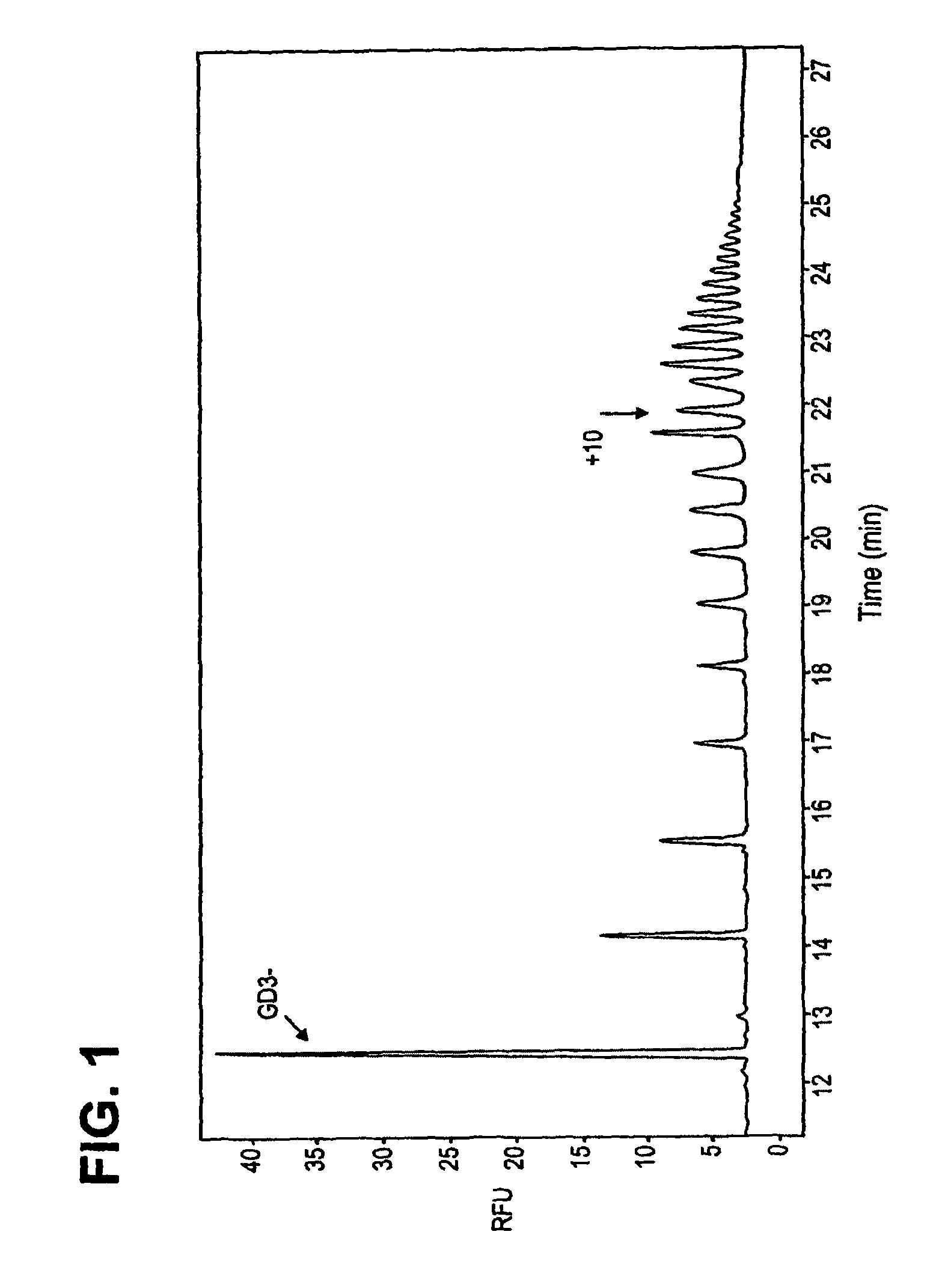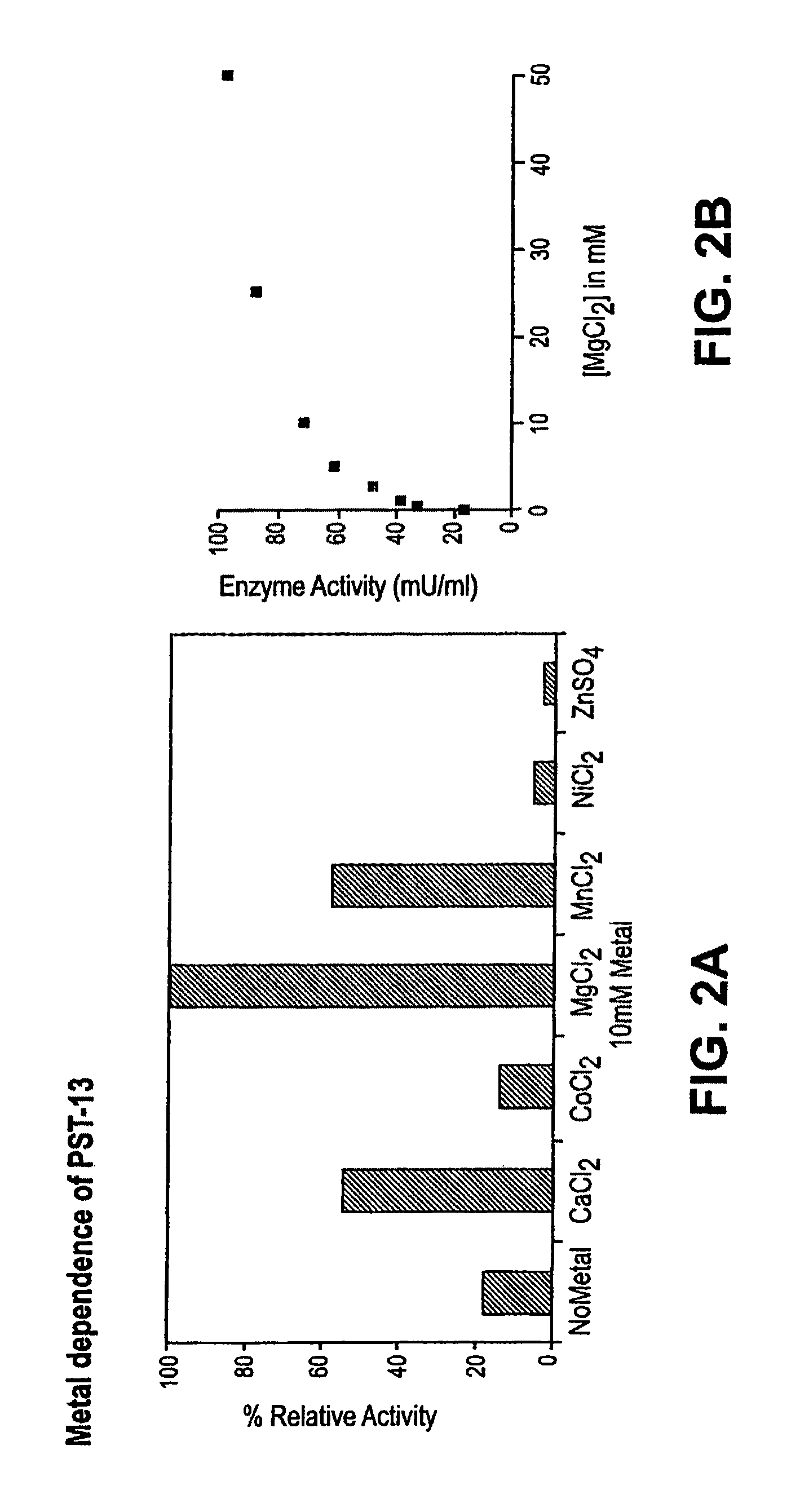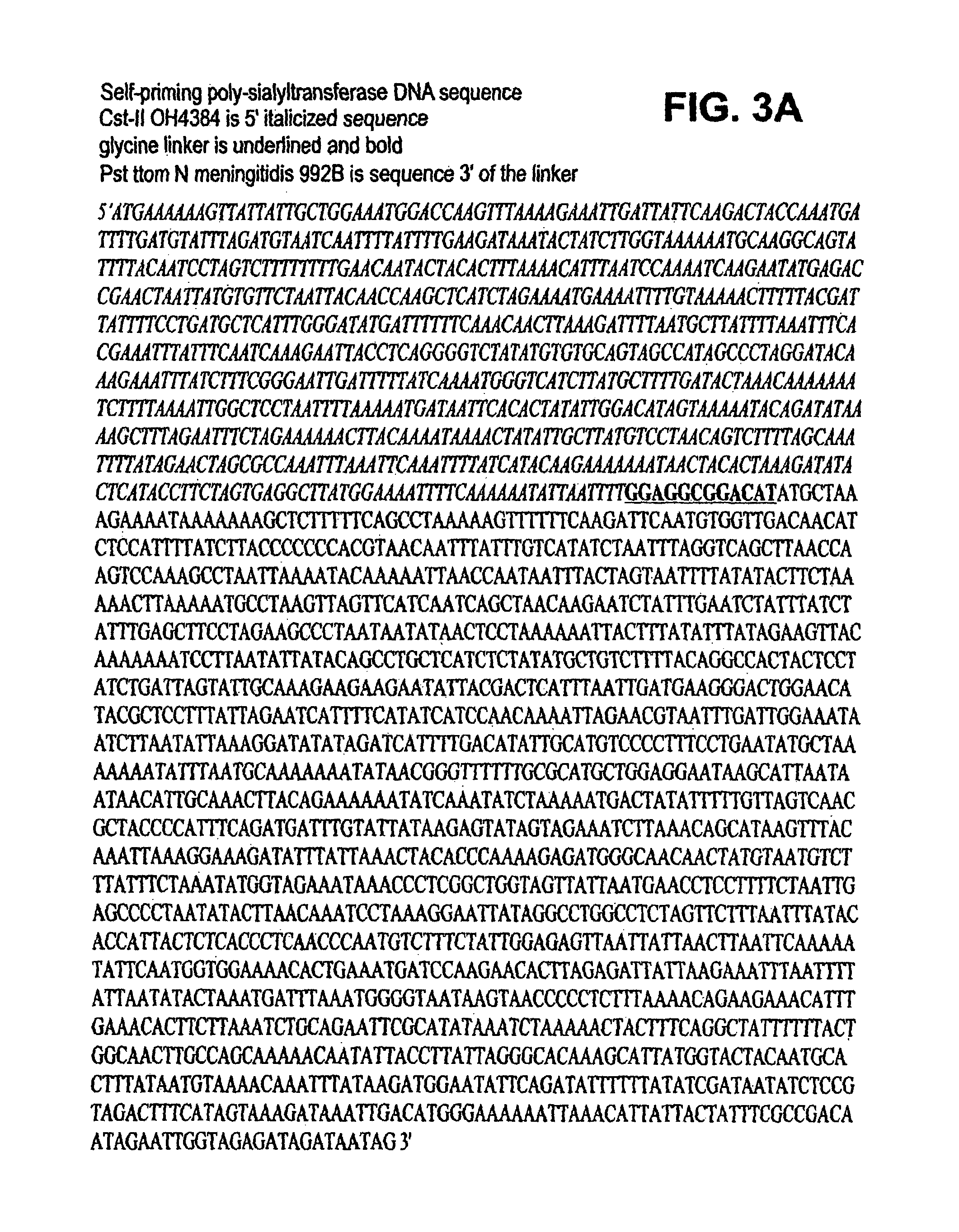Self-priming polysialyltransferase
a polysialyltransferase and self-priming technology, applied in the field of fusion proteins, can solve the problems of hampered enzymology study, no work on the fundamental aspects of the enzymology of the sialyltransferase from bacterial pathogens, and little detailed work on the fundamental aspects of the sialyltransferase enzymology
- Summary
- Abstract
- Description
- Claims
- Application Information
AI Technical Summary
Benefits of technology
Problems solved by technology
Method used
Image
Examples
example 1
Analysis of Poly-Sialyltransferases from N. Meningitides and E. Coli
[0166]Cloning of PST nucleic acids in expression vectors. Poly-sialyltransferase (PST) nucleic acids were isolated from E. coli and N. meningitides. All DNA isolations, restriction enzyme digestions, ligations, and transformations were performed as recommended by the supplier. Enzymes were obtained from New England Biolabs (Mississauga, ON). Genomic DNA was isolated using a DNeasy Tissue kit (Qiagen Inc., Mississauga, Ontario). PCR was performed using Phusion polymerase and the program: 94° C. for 5 min, 30 cycles of 94° C. for 30 sec, 55° C. for 30 sec and 72° C. for 60 sec, and finally 72° C. for 10 min Primers for the E. coli PST were as follows:
[0167]
(SEQ ID NO: 28)5′-AAGGTATAAGACATATGATATTTGATGCTAGTTTAAAGAAGand(SEQ ID NO: 29)3′-CCTAGGTCGACTTACTCCCCCAAGAAAATCCTTTTATCGTGC.
[0168]The N. meningitidis PST was amplified in two stages to remove an internal NdeI site (T474C). Two separate PCR reactions were performed t...
example 2
Construction and Characterization of Self-Priming Poly-Sialytransferases
[0183]Nucleic acids that encode bifunctional α-2,3 / 2,8 sialytransferase (Cst-II) from C. jejuni were fused to nucleic acids that encode a poly-sialytransferase (Pst, siaD) from Neisseria meningitides. Fusions using Cst-II from Campylobacter jejuni strain OH4384 to PST nucleic acids are exemplified. The Cst-II OH4384 constructs includes the first 260 amino acids with the mutation I53S, which is known to stabilize the Cst-II proteins. See, e.g., Chiu, C. P. et al., Nat. Struct. Mol. Biol., 11:163-170 (2004). The Cst-II OH4384 nucleic acid was amplified with primers
[0184]
(SEQ ID NO: 33)5′-CTTAGGAGGTCATATGAAAAAAGTTATTATTGCTGGAAATG
which contains an NdeI site and
[0185]
(SEQ ID NO: 33′-GCTGGAGCTGGACATATGTCCGCCTCCAAAATTAATATTTTTTGAAAATTTTCC
which corresponds to the 3′ end of cst without a stop codon, followed by a three glycine linker and an NdeI site. The pCW pst plasmids were digested with NdeI and then ligated with Nde...
example 3
Glycoprotein Acceptor Substrates for Self-Priming Poly-Sialyltransferases
[0194]The poly-sialyltransferase of PST17 was tested using a partially glycosylated IFNα2b[GalNAc-Gal-NeuAc]-FCHASE glycopeptide. Assay conditions were as follows: 50 mM NaHEPES pH 7.5, 5 mM MnCl2, 5 mM MgCl2, 5 mM CMP-NeuAc, 0.0684 mM IFNα2b[GalNAc-Gal-NeuAc]-FCHASE glycopeptide. Reactions were incubated at 37° C. for 1 hour and 2 hours. A negative control did not include CMP-NeuAc in the reaction mixture. Results of TLC and CB analysis is shown in FIG. 8. After 1 hour incubation at 37° C. there is 49.9% conversion to sialylated product and after 2 hours there is 62.5% conversion to sialylated product. CE traces in FIG. 8 clearly show that the products have multiple sialic acid residues attached. A glycopeptide acceptor was also a very good acceptor for the PST-17 fusion protein, and long PSA polymers could be seen in CE analysis of those reactions. (Data not shown.) The glyco-peptide acceptors, NH2-VGVT[GalNA...
PUM
| Property | Measurement | Unit |
|---|---|---|
| Tm | aaaaa | aaaaa |
| temperature | aaaaa | aaaaa |
| temperature | aaaaa | aaaaa |
Abstract
Description
Claims
Application Information
 Login to View More
Login to View More - R&D
- Intellectual Property
- Life Sciences
- Materials
- Tech Scout
- Unparalleled Data Quality
- Higher Quality Content
- 60% Fewer Hallucinations
Browse by: Latest US Patents, China's latest patents, Technical Efficacy Thesaurus, Application Domain, Technology Topic, Popular Technical Reports.
© 2025 PatSnap. All rights reserved.Legal|Privacy policy|Modern Slavery Act Transparency Statement|Sitemap|About US| Contact US: help@patsnap.com



